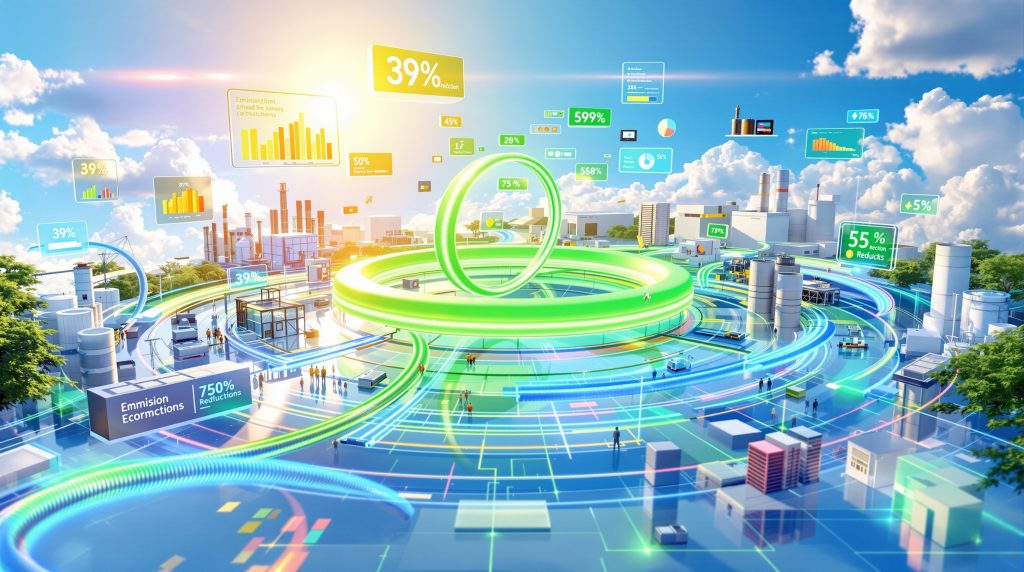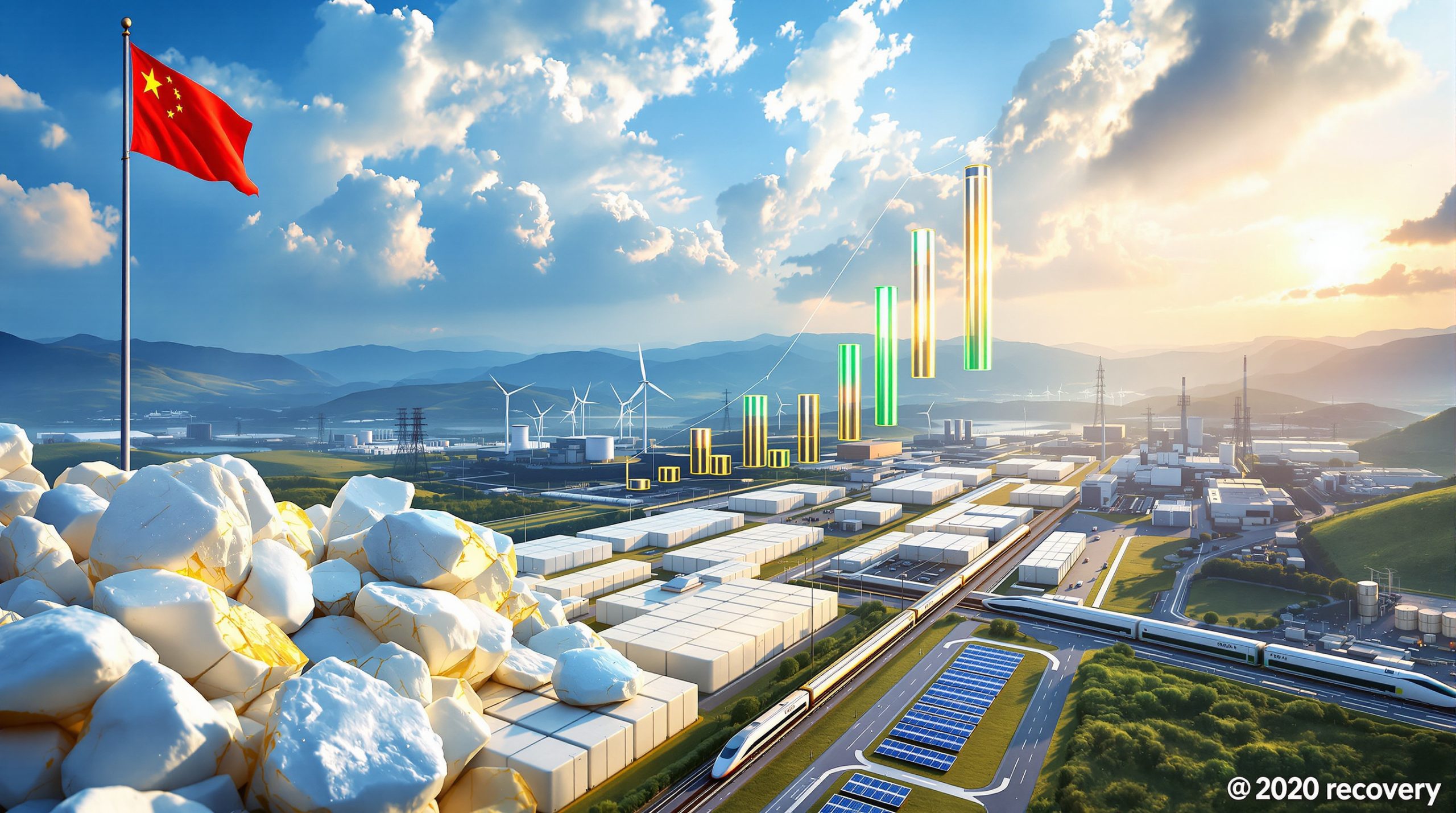The circular economy in decarbonization represents a transformative approach that fundamentally reimagines how societies manage resources while pursuing climate goals. Unlike traditional linear models that follow a "take-make-dispose" pattern, circular systems create closed loops where materials continuously cycle through productive uses, eliminating waste while dramatically reducing greenhouse gas emissions.
This paradigm shift addresses a critical challenge revealed by recent research from Tsinghua University: global demand for energy transition minerals could reach 40 million tonnes by 2040, potentially creating new resource dependencies that undermine decarbonisation in mining efforts. The circular economy in decarbonization offers a pathway to break this cycle by maximizing material value retention while minimising environmental impact.
Core Principles of Circular Decarbonization
Circular decarbonization operates through four interconnected principles that optimise resource flows while reducing carbon emissions. These foundational elements create regenerative systems that maintain economic productivity without depleting natural resources.
Resource regeneration forms the cornerstone of circular systems, distinguishing between biological nutrients that safely return to natural cycles and technical materials that circulate indefinitely through human systems. This separation ensures materials maintain their highest value while avoiding contamination that typically degrades recycling processes.
Waste elimination occurs through design strategies that anticipate entire product lifecycles, incorporating disassembly protocols and modular architectures that enable component recovery and reuse. This approach transforms traditional waste streams into valuable input materials for new production cycles.
Value retention extends product utility through sharing platforms, repair services, refurbishment programmes, and remanufacturing processes that restore products to like-new condition. These strategies delay material cycling while maximising economic returns from existing resources.
System optimisation leverages digital technologies including predictive analytics, blockchain traceability, and AI in mining optimization to coordinate complex material flows across multiple stakeholders, reducing inefficiencies and transportation emissions.
How Does Circular Economy Drive Carbon Emission Reductions?
The circular economy in decarbonization delivers substantial carbon savings through multiple pathways that address both direct emissions from industrial processes and indirect emissions embedded throughout supply chains. Research indicates these approaches can reduce global greenhouse gas emissions by up to 39% through strategic material management and lifecycle optimisation.
Direct Emission Reductions Through Material Cycling
Material cycling eliminates energy-intensive extraction and processing activities that generate substantial carbon emissions. Virgin aluminium production, for example, requires 15 times more energy than processing recycled aluminium, while recycled steel production consumes 75% less energy than primary steelmaking from iron ore.
Critical mineral recycling offers particularly significant benefits for decarbonisation technologies. Bio-leaching processes for electronic waste recovery consume 85% less energy than traditional smelting while eliminating toxic emissions that typically accompany pyrometallurgical processing. These biological systems use microorganisms to extract valuable materials including rare earth elements, gold, and platinum-group metals with minimal environmental impact.
However, magnet-to-magnet rare earth recycling represents another breakthrough technology that maintains material purity while avoiding environmentally destructive mining operations. This closed-loop approach recovers neodymium, dysprosium, and other critical elements directly from permanent magnets, eliminating the need for new extraction that typically involves radioactive thorium processing.
Scope 3 Emissions Management
The circular economy in decarbonization particularly excels at addressing Scope 3 emissions that occur throughout value chains but remain outside direct organisational control. These indirect emissions often represent 70-90% of total corporate carbon footprints, making circular strategies essential for comprehensive decarbonisation.
| Emission Source | Linear Model Impact | Circular Reduction Potential |
|---|---|---|
| Material extraction | High energy intensity from mining | 60-80% reduction through recycling |
| Manufacturing processes | Virgin material processing | 40-70% energy savings from secondary materials |
| Product transportation | Global supply chains | Localised material loops reduce transport needs |
| End-of-life management | Landfill methane emissions | Zero waste through complete material recovery |
Extended product lifespans through repair and refurbishment programmes delay replacement cycles, reducing manufacturing demand and associated emissions. Industrial equipment lifetime extension strategies can reduce carbon footprints by 30-50% while maintaining operational performance through predictive maintenance and component upgrading.
What Are the Key Circular Technologies Enabling Decarbonization?
Technological innovation drives the circular economy in decarbonization through breakthrough processes that maximise material recovery while minimising environmental impact. Furthermore, these technologies address critical bottlenecks in traditional recycling systems while enabling new circular business models.
Advanced Material Recovery Systems
Bio-leaching Technologies
Biological material recovery systems represent a paradigm shift from energy-intensive mechanical and thermal processes to low-impact biological extraction. These systems employ specialised microorganisms including acidophilic bacteria that naturally concentrate and separate valuable materials from complex waste matrices.
Recent advances in bio-leaching can process electronic waste at ambient temperatures while achieving recovery rates exceeding 95% for precious metals and rare earth elements. The process eliminates toxic emissions associated with high-temperature smelting while requiring minimal energy input beyond basic aeration and pH control.
Magnet-to-Magnet Rare Earth Recycling
Direct recycling of permanent magnets addresses critical minerals supply chain vulnerabilities while eliminating environmental impacts from primary rare earth mining. This technology processes end-of-life magnets from wind turbines, electric vehicles, and consumer electronics without breaking down the magnetic material structure.
The process maintains magnetic performance equivalent to virgin materials while reducing processing energy by 80% compared to traditional rare earth refining. This approach becomes increasingly valuable as global rare earth demand is projected to triple by 2030 for clean energy applications.
Digital Optimisation Platforms
Predictive Analytics for Resource Flows
Machine learning systems optimise circular material flows by analysing demand patterns, identifying bottlenecks, and coordinating supply networks to minimise waste and transportation emissions. These platforms process real-time data from sensors, market signals, and logistics networks to enable dynamic resource allocation.
Advanced algorithms can reduce material waste by 25-40% through improved demand forecasting and inventory optimisation. Transportation emissions decrease by 30-60% through route optimisation and load consolidation across circular supply networks.
Blockchain-Enabled Traceability
Distributed ledger technologies create transparent material passports that track carbon footprints, recycling history, and quality metrics throughout complex supply networks. These digital identities enable precise impact accounting and authentic circular practice verification.
Blockchain systems support certified recycling programmes by providing tamper-proof records of material provenance and processing history. This transparency enables premium pricing for verified circular materials while reducing fraud in recycling markets.
Which Industries Benefit Most from Circular Decarbonization?
Specific industries demonstrate exceptional potential for circular economy in decarbonization due to their material intensity, established supply chains, and economic incentives for resource recovery. These sectors serve as proving grounds for circular technologies while generating substantial carbon savings.
Energy Storage and Battery Systems
The battery industry exemplifies successful circular decarbonisation through comprehensive lifecycle management strategies that address critical material supply risks. With battery demand projected to increase 10-fold by 2030 for electric vehicles and grid storage, circular approaches become essential for sustainable scaling.
Design Phase Innovations:
• Modular battery architectures enable component-level replacement and upgrading
• Standardised chemistries facilitate cross-manufacturer recycling processes
• Digital twins optimise performance prediction and maintenance scheduling
• Material selection prioritises recyclability and supply chain resilience
End-of-Life Value Recovery:
Modern battery recycling breakthrough processes achieve 95% recovery rates for lithium, cobalt, and nickel through advanced hydrometallurgical processes. These materials maintain sufficient purity for direct reuse in new battery production, creating closed-loop supply chains that reduce mining dependence.
Direct recycling technologies preserve cathode material integrity, maintaining 90% of original battery performance while reducing processing energy by 60% compared to traditional pyrometallurgical methods. This approach becomes increasingly valuable as cobalt prices average $35,000 per tonne and lithium carbonate exceeds $15,000 per tonne.
Second-life applications extend battery utility in stationary energy storage systems where performance requirements allow continued use of degraded automotive batteries. These applications capture 60-80% of residual battery value while providing grid stabilisation services.
Construction and Built Environment
The construction industry generates 40% of global carbon emissions and consumes 50% of extracted materials, making circular approaches essential for meaningful decarbonisation progress. Consequently, circular construction practices deliver massive carbon savings through systematic material management strategies.
Material Banks and Design for Disassembly:
Buildings designed as material banks incorporate detailed inventories of embedded materials, connection systems that enable non-destructive disassembly, and standardised components that facilitate reuse across projects. These strategies can reduce construction carbon footprints by 40-70% while creating valuable material streams for future projects.
Prefabricated Modular Systems:
Modular construction enables systematic component recovery and reuse through standardised interfaces and reversible connections. Factory production improves material efficiency by 20-30% while reducing construction waste by 90% compared to traditional building methods.
Bio-based Carbon Sequestration:
Engineered wood products and other bio-based materials sequester atmospheric carbon while providing structural performance. Cross-laminated timber buildings can sequester 200-300 tonnes of CO2 per structure while enabling end-of-life material recovery for cascading uses.
How Can Businesses Implement Circular Decarbonization Strategies?
Successfully implementing circular economy in decarbonization requires systematic approaches that integrate circular thinking throughout business operations, supply chains, and customer relationships. Organisations must develop comprehensive strategies that address technical, economic, and organisational challenges while capitalising on emerging opportunities.
Strategic Framework Development
Phase 1: Material Flow Mapping and Impact Assessment
Comprehensive material flow analysis provides the foundation for circular strategy development by quantifying resource inputs, transformation processes, and output streams. This assessment identifies optimisation opportunities and establishes baseline carbon intensity measurements across operations.
Organisations should analyse Scope 1, 2, and 3 emissions with particular attention to upstream supply chain impacts and end-of-life management. Material flow mapping reveals hidden dependencies on critical materials and exposes vulnerability to supply chain disruptions.
Phase 2: Circular Design Integration
Product development must incorporate circular principles from conceptual stages through market deployment, considering durability, repairability, upgradability, and end-of-life recovery. Design for circularity typically requires 15-25% additional upfront investment but delivers 200-400% returns through extended product life and material recovery value.
Phase 3: Partnership Ecosystem Development
Circular systems require collaborative networks spanning suppliers, customers, recyclers, and technology providers. These partnerships enable shared infrastructure investments, risk distribution, and coordinated material flows that individual organisations cannot achieve independently.
Implementation Roadmap
Critical Success Factor: The circular economy in decarbonization requires systems thinking that optimises entire value networks rather than individual processes or products, addressing the projected tripling of energy transition mineral demand by 2030.
Immediate Actions (0-2 years):
• Comprehensive waste stream auditing and valorisation opportunity identification
• Supplier engagement programmes for circular material sourcing partnerships
• Product design reviews incorporating durability and end-of-life considerations
• Pilot project development demonstrating circular business model viability
Medium-term Transformations (2-5 years):
• Supply chain redesign for regional material circulation loops
• Technology investments in recovery and processing infrastructure
• Customer engagement programmes promoting product longevity and return
• Performance metrics integration tracking circular economy outcomes
Long-term System Integration (5+ years):
• Industry ecosystem leadership and standard development initiatives
• Major infrastructure investments in shared circular processing facilities
• Policy advocacy for supportive regulatory frameworks
• Innovation partnerships advancing breakthrough circular technologies
What Are the Economic Benefits of Circular Decarbonization?
The circular economy in decarbonization generates substantial economic benefits through cost reduction, revenue diversification, and risk mitigation. These financial advantages often exceed initial investment requirements within 2-4 years while providing long-term competitive advantages through resource security and regulatory compliance.
Cost Reduction Opportunities
Circular strategies deliver immediate savings through reduced material purchasing, energy consumption, and waste disposal costs. Organisations implementing comprehensive circular programmes typically achieve 15-40% raw material cost reductions while simultaneously improving environmental performance.
| Cost Category | Typical Savings Range | Implementation Timeframe | Investment Requirement |
|---|---|---|---|
| Raw material procurement | 15-40% reduction | 1-3 years | Low to moderate |
| Energy consumption | 20-60% decrease | 2-4 years | Moderate to high |
| Waste disposal fees | 70-95% elimination | 1-2 years | Low |
| Regulatory compliance | 10-30% cost avoidance | Ongoing | Moderate |
| Transportation costs | 25-50% reduction | 2-3 years | Moderate |
Energy savings from circular processes compound over time as organisations optimise material flows and reduce processing requirements. Recycled aluminium production consumes 95% less energy than primary production, while recycled paper manufacturing uses 40% less energy than virgin fibre processing.
Revenue Generation Streams
Material Recovery Value Creation
High-value materials extracted from waste streams create new revenue opportunities while reducing disposal costs and supply chain risks. Electronic waste recycling can recover $50-100 per tonne in precious metals, while rare earth element recovery from permanent magnets generates $15-25 per kilogram in material value.
Critical materials face particularly strong market demand as supply chain vulnerabilities emerge. Silver shortages driven by solar photovoltaic expansion create premium pricing opportunities for recycled silver, while cobalt and nickel supply constraints increase recycled material values.
Service-Based Business Model Innovation
Product-as-a-service offerings generate recurring revenue while maintaining asset control and optimising utilisation rates through sharing platforms. These models typically increase revenue per asset by 50-200% while reducing customer capital requirements and improving operational flexibility.
Equipment-as-a-service programmes in manufacturing generate 25-40% higher margins than traditional sales models while ensuring product return for refurbishment and material recovery. This approach creates long-term customer relationships while capturing end-of-life material value.
Carbon Credit Monetisation
Verified emission reductions from circular practices generate tradeable carbon credits providing additional revenue streams. High-quality circular economy projects can generate credits valued at $15-50 per tonne CO2 depending on methodology and market conditions.
Material substitution and lifetime extension projects qualify for carbon credit certification under multiple standards including Verified Carbon Standard and Gold Standard protocols. These credits provide ongoing revenue while supporting corporate sustainability commitments.
How Do Policy Frameworks Support Circular Decarbonization?
Effective policy frameworks create enabling conditions for circular economy in decarbonization through regulatory requirements, economic incentives, and public investment coordination. These policies address market failures that prevent optimal circular outcomes while accelerating private sector adoption.
Regulatory Drivers and Incentives
Extended Producer Responsibility (EPR) Systems
Comprehensive EPR schemes require manufacturers to manage entire product lifecycles, creating strong economic incentives for circular design and end-of-life recovery systems. These policies internalise disposal costs while generating funding for recycling infrastructure development.
The European Union's Extended Producer Responsibility Directive covers 85% of products by weight including electronics, batteries, packaging, and textiles. EPR fees typically range from 2-8% of product value, making circular design economically attractive compared to disposal cost liability.
Carbon Pricing Mechanisms
Carbon taxes and emissions trading systems price environmental externalities into market decisions, making circular approaches economically competitive with linear alternatives. Carbon prices exceeding $50 per tonne CO2 create strong incentives for material cycling and lifetime extension strategies.
The European Union Emissions Trading System covers 40% of regional greenhouse gas emissions with carbon prices reaching $90 per tonne in 2024. These price signals drive investment in circular technologies while penalising wasteful linear practices.
Public Procurement Leadership
Government purchasing power creates demand for circular products and services while demonstrating market viability for private sector adoption. Public procurement represents 12-20% of GDP in developed economies, providing substantial market scale for circular innovation.
Circular procurement policies prioritise durability, repairability, and material recovery potential over lowest initial cost. These requirements drive market development for circular products while demonstrating long-term value creation through total cost of ownership approaches.
International Coordination Initiatives
Critical Raw Materials Partnerships
Multilateral agreements coordinate circular supply chain development while reducing geopolitical risks through diversified sourcing strategies. The Minerals Security Partnership includes 14 countries representing major consuming and producing regions for critical materials.
These partnerships facilitate technology transfer, investment coordination, and trade facilitation for circular material flows. Joint infrastructure investments reduce individual country risks while accelerating global circular economy deployment.
Technology Transfer and Capacity Building
International cooperation accelerates circular technology deployment through knowledge sharing, capacity building programmes, and coordinated research investments. Development finance institutions provide $10-15 billion annually for circular economy projects in emerging markets.
Technology transfer programmes focus on adaptable solutions including small-scale recycling technologies, bio-based material processing, and digital traceability systems. These programmes build local capacity while creating global markets for circular innovations.
What Challenges Must Be Overcome for Successful Implementation?
Despite significant potential benefits, the circular economy in decarbonization faces substantial technical, economic, and social challenges that require coordinated solutions across multiple stakeholders. Understanding these barriers enables more effective strategy development and risk mitigation.
Technical and Infrastructure Barriers
Material Quality Degradation in Recycling Cycles
Repeated recycling can degrade material properties through contamination, polymer chain breakdown, and alloy composition changes. Plastic recycling typically achieves only 2-3 cycles before material degradation prevents further use, while metal recycling maintains properties indefinitely with proper separation.
Advanced sorting technologies including AI-powered optical recognition and molecular identification can maintain higher material quality through improved contamination control. These systems achieve 95-99% purity levels compared to 80-90% for conventional sorting methods.
Scale Mismatches Between Local Systems and Economic Viability
Circular systems require sufficient material volumes to achieve economic efficiency while maintaining environmental benefits through reduced transportation. Small-scale recycling facilities typically require 50,000-100,000 tonnes annual capacity for economic viability, challenging local circular system development.
Regional hub-and-spoke models coordinate local collection with centralised processing to achieve necessary scale while minimising transportation impacts. These networks reduce transportation distances by 60-80% compared to traditional centralised systems.
Economic and Market Challenges
Capital Investment Requirements and Payback Periods
Circular infrastructure demands significant upfront capital with payback periods often exceeding 5-7 years compared to 2-3 years for conventional alternatives. Material recovery facilities require $100-500 million in initial investment depending on technology and capacity.
Innovative financing mechanisms including green bonds and circular economy solutions address capital barriers through risk sharing and extended payback acceptance. These instruments provide $50-100 billion annually in circular economy financing globally.
Consumer Behaviour Transformation Requirements
Successful circular systems depend on consumer adoption of sharing, repair, and return behaviours that may conflict with convenience preferences and ownership psychology. Consumer willingness to pay premiums for circular products typically ranges from 5-15% above conventional alternatives.
Education programmes and incentive structures can accelerate behaviour change by demonstrating value proposition and reducing participation barriers. Take-back programmes with deposit systems achieve 80-95% return rates compared to 20-40% for voluntary return programmes.
Measurement and Verification Issues
Key Challenge: Accurate measurement of circular economy impacts requires comprehensive lifecycle assessment methodologies and transparent reporting standards to verify the projected 39% emission reduction potential through circular approaches.
Data Availability and Quality Gaps
Limited availability of reliable data on material flows, recycling rates, and environmental impacts hampers decision-making and progress tracking. Material flow accounting exists for only 60% of critical materials with significant gaps in recycling and trade data.
Digital tracking systems using blockchain and IoT sensors can improve data quality while reducing reporting costs. These systems provide real-time visibility into material flows while automating compliance reporting and impact verification.
Standardisation and Certification Challenges
Absence of universal metrics and reporting standards creates confusion and prevents effective comparison of circular initiatives across organisations and regions. Over 200 different circular economy indicators exist without consensus on core measurement approaches.
International standardisation efforts through ISO and other bodies aim to establish consistent methodologies for circular economy measurement and reporting. These standards enable reliable impact quantification and investment decision support.
Future Outlook: Scaling Circular Decarbonization Globally
The future of circular economy in decarbonization depends on breakthrough technology deployment, supportive policy development, and fundamental shifts in business models and consumer behaviour. Recent research on industrial decarbonisation strategies projecting material demand increases of 300% by 2030 makes circular solutions increasingly urgent for sustainable decarbonisation.
Emerging Technology Trends
Artificial Intelligence Integration
Advanced AI systems optimise complex circular networks by predicting material flows, coordinating logistics, and identifying emerging opportunities for waste valorisation. Machine learning algorithms process data from sensors, market signals, and supply chain networks to enable real-time optimisation of circular systems.
AI-powered sorting systems achieve 99% accuracy in material identification while processing 10-20 tonnes per hour. These systems enable cost-effective recycling of complex material streams including electronics, composites, and mixed plastics previously considered uneconomical.
Biotechnology Applications
Engineered biological systems enable new circular processes including plastic-eating enzymes, bio-based material production, and enhanced recovery of valuable elements from waste streams. Synthetic biology approaches can create custom organisms optimised for specific circular applications.
Plastic-degrading enzymes achieve 90% breakdown of PET plastics within 24 hours under controlled conditions, enabling molecular-level recycling that maintains original material quality. These biological systems operate at ambient temperatures while avoiding harsh chemicals required by conventional recycling.
Market Transformation Projections
Comprehensive circular economy implementation could reduce global material extraction by 28% while maintaining economic growth, demonstrating potential for decoupling resource consumption from prosperity. This transformation requires coordinated action across technology, policy, and finance sectors.
Key Growth Drivers:
• Carbon pricing expansion creating economic incentives for circular practices
• Resource scarcity driving innovation in recovery and substitution technologies
• Consumer demand shift toward sustainable products and service models
• Regulatory requirements mandating circular design and recovery targets
• Financial sector integration of circular metrics into investment decisions
Strategic Recommendations for Organisations
Organisations should develop integrated circular strategies combining technological innovation, business model transformation, and stakeholder engagement across entire value networks. Success requires long-term commitment and willingness to redesign fundamental business processes.
Priority Action Areas:
Building circular capabilities through strategic partnerships enables shared investment and risk distribution while accessing specialised expertise. Technology investments should prioritise scalable solutions with demonstrated economic viability and environmental impact.
Active participation in policy development and industry standard creation shapes enabling frameworks while positioning organisations for regulatory compliance and competitive advantage. Early adoption of circular practices creates first-mover advantages in emerging markets.
Furthermore, organisations must consider mine reclamation innovations as part of their circular strategies, ensuring sustainable resource extraction practices that align with circular economy principles.
Cultural transformation programmes engage employees and customers in circular economy principles while building organisational capabilities for systems thinking and lifecycle optimisation. These programmes create sustainable competitive advantages through embedded circular competencies.
Disclaimer: This article presents analysis of emerging trends in circular economy and decarbonisation based on current research and industry developments. Future outcomes may vary significantly due to technological, economic, and policy changes. Financial projections and market forecasts should not be considered investment advice. Organisations should conduct thorough due diligence before implementing circular economy strategies.
Are You Looking to Capitalise on Australia's Energy Transition Opportunities?
Discovery Alert delivers instant notifications on significant ASX mineral discoveries using its proprietary Discovery IQ model, helping investors identify critical materials opportunities as demand for energy transition minerals soars towards 40 million tonnes by 2040. With the circular economy driving unprecedented demand for battery metals and rare earth elements, begin your 30-day free trial today to position yourself ahead of the market in Australia's next wave of critical mineral discoveries.




